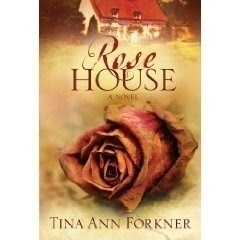 The cover of Tina Forkner’s novel Rose House grabbed me. The back cover description intrigued me. But the story itself failed to capture or keep my attention. I found the first few chapters confusing, some of the dialogue stilted, and the flashbacks in the beginning distracting and unnecessary.
The cover of Tina Forkner’s novel Rose House grabbed me. The back cover description intrigued me. But the story itself failed to capture or keep my attention. I found the first few chapters confusing, some of the dialogue stilted, and the flashbacks in the beginning distracting and unnecessary.
The premise of the novel is that Lillian is horrified to discover a painter had observed her grief when she thought herself alone at the Rose House, yet in the first chapter of the novel, she runs away from the Rose House after finding two other men—one with a cell phone and one with a camera photographing her—there too. If she knew she was observed by a photographer, why her huge shock at being observed by an artist who then painted her?
In her endorsement of the novel, Patti Lacy says, “Don’t get lulled into a sense of calm; the story line casts suspenseful shadows on this masterpiece of women’s fiction.” However, I found the suspense rather flat. At the beginning, it is hinted that Lillian’s husband and children were murdered and the police are conducting an investigation; Lillian also fears she is being followed. Then four years suddenly lapse without warning (no little “Four Years Later” note), and the investigation and fear of being followed are forgotten. There weren’t enough details or information to support the suspense, even when the author tried to bring it up again later in the novel.
Forkner does have a way with words, as many of her descriptions showed. The opening paragraph—or opening sentence—made me read it twice: “It seemed to be a cottage that was alive, but it was only the vines twining in on themselves and clinging to the structure that were living, not unlike the memories and feelings people had attached to the house over time, making it mean more than mere sticks, pieces of wood, nails, and peeling paint could ever imply on their own.” That completely captures the essence of the Rose House—a beautiful, brilliant opening to a story centered around a building that almost seemed to be a character itself.
I appreciated that Forkner didn’t make it easy for Lillian and her sister Geena to reconcile, nor did she downplay Geena’s struggles to give up her addictions and make a new life for herself. Aunt Bren, however, didn’t seem real, but more of someone for both Lillian and Geena to call as a way to give the reader information.
It was only when I reached the end of the book did I realize that this book is a sequel, though it stands on its own in a way. The story of the Rose House is told in another book, Ruby Among Us, which explains why the story that I kept waiting for in Rose House never came out. Overall, I found it a disappointing read—one that could have been as breathtaking and beautiful as the cover, but was instead rather flat and uninspiring.
Tina Forkner is a substitute teacher, wife, and mom with three teenagers. She enjoys traveling, gardening, hiking, knitting and drinking mochas. She also writes poetry, essays and short articles.
Back-to-School fiction from Waterbrook:
- The Confidential Life of Eugenia Cooper by Kathleen Y’Barbo
- The Sweetgum Ladies Knit for Love by Beth Patillo
This book was provided for review courtesy of the publisher or publicist. This post contains affiliate links; as an Amazon Associate, I earn from qualifying purchases.

No Responses Yet